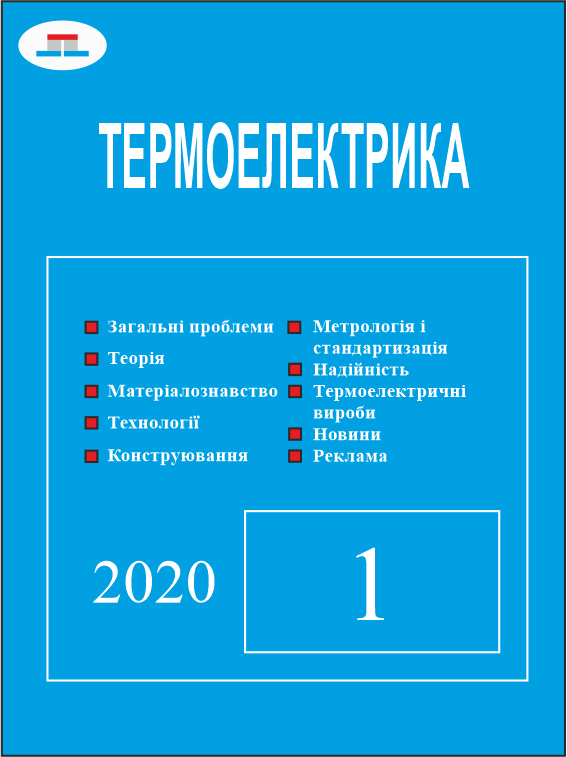Поляризаційна модель теплоконтрастних об’єктів спостереження
Ключові слова:
поляризаційний тепловізор, температурне розділення, частково поляризоване випромінювання, ступінь поляризаціїАнотація
У статті запропоновано поляризаційну модель тепловізора з метою його застосування при дослідженні термоелектричних явищ і пристроїв, що дозволяє підвищити ефективність роботи таких пристроїв. Для дослідження і проектування таких тепловізорів розглянута фізико-математична модель поляризації випромінювання від об’єктів спостереження, яка враховує поляризаційні властивості власного теплового випромінювання і відбитого зовнішнього випромінювання. Розроблена модель була застосована для визначення поляризаційних властивостей випромінювання плоскої залізної пластини. Аналіз отриманих результатів свідчить про те, що для теплового випромінювання при кутах спостереження ψ < 40° складові коефіцієнта випромінювання є майже однаковими ε_∥ ≈ ε_⊥ ≈ 0.16, але ε_∥ < ε_⊥. Із збільшенням кута спостереження ψ<40° перпендикулярна поляризаційна компонента ε_⊥ монотонно зменшується до нуля, а паралельна компонента ε_∥ збільшується і досягає максимального значення при куті ψ=84°, а потім зменшується до нуля. Ступінь поляризації випромінювання зростає із збільшенням кута ψ і при куті ψ = 84° дорівнює 0.96. Отримані результати досліджень доцільно використовувати при розробці моделі термоелектриків, яка може використовуватись при проектуванні поляризаційного тепловізора. Бібл. 8, рис. 7, табл. 1.
This paper proposes a polarization model of a thermal imager for the purpose of its application in the study of thermoelectric phenomena and devices, which allows increasing the efficiency of such devices. To study and design such thermal imagers, a physico-mathematical model of polarization of radiation from observation objects is considered, which takes into account the polarization properties of the intrinsic thermal radiation and the reflected external radiation. The developed model was used to determine the polarization properties of the radiation from a flat iron plate. The analysis of the obtained results shows that for thermal radiation at observation angles ψ <40 ° the components of the radiation coefficient are almost identical ε∥≈ε⊥≈0.16, but ε∥ <ε⊥. As the observation angle ψ <40 ° increases, the perpendicular polarization component ε⊥ decreases monotonically to zero, and the parallel component ε∥ increases and reaches its maximum value at an angle ψ = 84 °, and then decreases to zero. The degree of polarization of radiation increases with increasing angle ψ and at an angle ψ = 84 ° is equal to 0.96. The obtained research results are worthwhile to be used in the development of a model of thermoelectrics which can be employed in the design of a polarization thermal imager. Bibl. 8, Tabl. 1, Fig. 7.
Посилання
Zhao Yonqiang, Yi Chen, Kog Seong G., Pan Quan, Cheng Yongmei (2016). Multi-band polarization imaging and applications. Berlin Heidelberg: National Defense Industry Press, Beijing and Springer-Verlag.
Yang Bin, Wu Taixia, Chen Wei, Li Yanfei, Knjazhikhin Yuri, et.al. (2017). Polarization remote sensing physical mechanism, key methods and application. The International Archives of the Photogrammetry, Remote Sensing and Spatial Information Sciences, XLII-2/W7, 956-960.
Anatychuk L.I., Vikhor L.M., Kotsur M.P., Kobylianskyi R.R., Kadeniuk T.Ya. (2016).Optimal control of time dependence of cooling temperature in thermoelectric devices. J.Thermoelectricity, 5, 5-11.
Born M., Wolf E. (2002). Principles of optics, 7th ed., Cambridge University Press.
Vollmer Michael and Mollman Klaus-Peter (2018). Infrared thermal imaging. Fundamentals, research and applications. 2nd ed. Weinheim: Wiley – VCH.
Kolobrodov V.G., Lykholit M.I. (2007). Design of thermal imaging and television surveillance systems. Kyiv: NTUU “ KPI” [in Ukrainian].
Siegel R., Howell J.R. (1981). Thermal radiation heat transfer, 2nd ed. Hemisphere Publishing Corp.
Vollmer M., Karstadt S., Mollman K-P., Pinno F. (2001). Identification and suppression of thermal imaging. InfraMation Proceedings. University of Applied Sciences: Brandenburg (Germany).




